 San Juan
San Juan
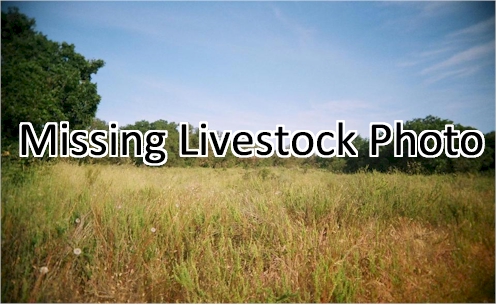 San Juan pigs, indigenous to the picturesque island of Puerto Rico, embody resilience and adaptability in their genetic makeup. These hardy creatures thrive in diverse environments and varied feed conditions, showcasing their remarkable ability to adjust to changing surroundings.
San Juan pigs, indigenous to the picturesque island of Puerto Rico, embody resilience and adaptability in their genetic makeup. These hardy creatures thrive in diverse environments and varied feed conditions, showcasing their remarkable ability to adjust to changing surroundings.
Sporting a sleek black or dark brown coat adorning their medium-sized bodies, San Juan pigs boast a distinctive broad snout, adding to their unique charm. Renowned for their delectable meat, prized for its enhanced flavor and tenderness compared to commercial breeds, San Juan pigs stand out as culinary delights.
One of their most remarkable traits is their adeptness at foraging, as they effortlessly procure a substantial portion of their suste ...

 Sarda
Sarda
 Sarda Pigs, originating from the picturesque island of Sardinia in Italy, epitomize the rugged charm of their homeland. Resembling their wild boar counterparts, with whom they often intermingle in the lush underbrush and scrublands where they graze, these pigs have been officially recognized as one of Italy''s indigenous swine breeds since 2006.
Sarda Pigs, originating from the picturesque island of Sardinia in Italy, epitomize the rugged charm of their homeland. Resembling their wild boar counterparts, with whom they often intermingle in the lush underbrush and scrublands where they graze, these pigs have been officially recognized as one of Italy''s indigenous swine breeds since 2006.
These pigs boast a compact stature, reaching a mature weight of 70-100 kg. Their coats exhibit a striking array of colors, including black, grey, tawny, and spotted patterns, while their dense and coarse bristles form a distinctive mane along the dorsal line.
Characterized by a cone-shaped head with a straight profile, Sarda Pigs feature small ears positioned either upright or ...

 Semirechye
Semirechye
 Semirechye pigs, originating from Kazakhstan, are a versatile and adaptable breed known for their ability to serve various purposes in agricultural settings.
Semirechye pigs, originating from Kazakhstan, are a versatile and adaptable breed known for their ability to serve various purposes in agricultural settings.
These pigs, known as "Semirechye" which translates to "Seven Rivers" in reference to the region they come from, are valued for their versatility and hardiness. They are well-suited for a range of tasks, making them a popular choice among farmers for both meat and other agricultural purposes.
With their robust nature and adaptability to different environmental conditions, Semirechye pigs play a crucial role in the agricultural landscape of Kazakhstan, contributing to the livelihoods of many farmers in the region.

 Shaziling
Shaziling
 Shaziling pigs, also known as Shazi pigs, are an indigenous breed of domestic swine originating from the Shazi Township in Hunan Province, China. They are characterized by their distinctive black and white markings, compact build, and hardy temperament.
Shaziling pigs, also known as Shazi pigs, are an indigenous breed of domestic swine originating from the Shazi Township in Hunan Province, China. They are characterized by their distinctive black and white markings, compact build, and hardy temperament.
Shaziling pigs are considered medium-sized hogs, typically weighing between 180 and 250 kilograms (397 and 551 pounds) at maturity. Boars tend to be slightly larger than sows.
They have a compact and muscular build, with a slightly arched back and a deep chest. Their heads are medium in size, featuring erect ears and a slightly dished snout.
Their coats exhibit a distinctive black and white pattern, with the black patches typically covering the head, should ...

 Siberian Black Pied
Siberian Black Pied
 Siberian Black Pied Pigs, hailing from Russia, have a unique origin story intertwined with the development of the North Siberian breed. Initially emerging from stock that did not meet the criteria for the North Siberian lineage, these pigs were carefully cultivated to form a distinct breed known as the Siberian Black Pied.
Siberian Black Pied Pigs, hailing from Russia, have a unique origin story intertwined with the development of the North Siberian breed. Initially emerging from stock that did not meet the criteria for the North Siberian lineage, these pigs were carefully cultivated to form a distinct breed known as the Siberian Black Pied.
Primarily concentrated in the Novosibirsk region, their population has fluctuated between 4,000 to 12,000 since the 1960s. This specialized breed showcases the resilience and adaptability required to thrive in the rugged landscapes and diverse climates of the Siberian region.

 Small Black
Small Black
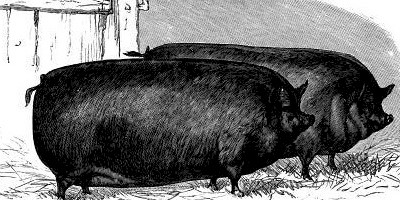 Small Black, or Suffolk, Pigs are extinct pigs from the United Kingdomduring the nineteenth century.
Small Black, or Suffolk, Pigs are extinct pigs from the United Kingdomduring the nineteenth century.Their origin is uncertain, but mostly likely there were a cross between Essexpigs and foreign breeds in efforts to improve it. The Small Black closely resembled the, also now extinct, Small White, except they were black and had pricked ears and a short upturned snout - which indicates a contribution from imported Chinese pigs.
Small Black Pigs seems to have had a rather mixed reputation amongst agriculturalists. By the turn of the 20th century they were quickly becoming unpopular and they were said to have a delicate constitution and a too large percentage of fat, although it matured early.
They appear ...

 Small White
Small White
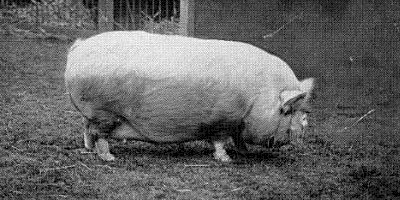 The Small White, also known as Small Yorkshire, Pigs, were a notable breed originating in the United Kingdom, prominent during the nineteenth century. This breed, although now extinct, played a significant role in the development of modern swine breeds, including the Middle White and others, by contributing its distinctive characteristics.
The Small White, also known as Small Yorkshire, Pigs, were a notable breed originating in the United Kingdom, prominent during the nineteenth century. This breed, although now extinct, played a significant role in the development of modern swine breeds, including the Middle White and others, by contributing its distinctive characteristics.
These pigs were renowned for their compact size and robust build, making them well-suited for various agricultural purposes prevalent during their time. With their white coats and distinctive features, they were prized for their versatility and adaptability to different farming environments.
During the peak of their existence, Small White Pigs were a common sight across farms in the ...

 Super Pigs
Super Pigs
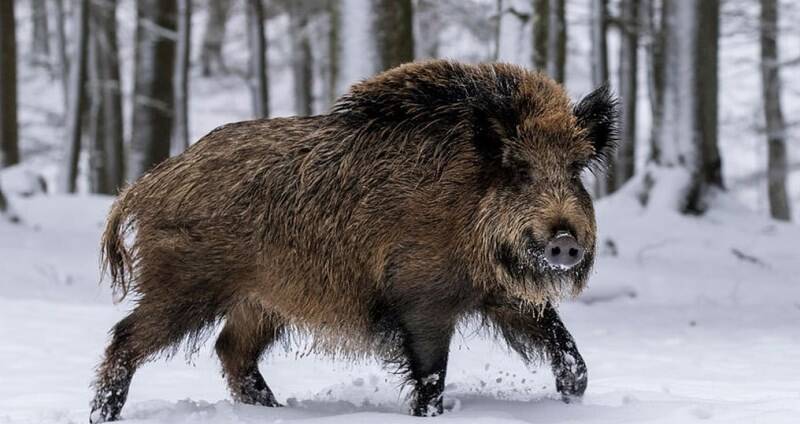 Super Pigs is not a singular breed, but a diverse mix of escaped domestic pigs and their descendants, have woven themselves into the fabric of the continent''s landscapes.
Super Pigs is not a singular breed, but a diverse mix of escaped domestic pigs and their descendants, have woven themselves into the fabric of the continent''s landscapes.Their story begins with domestication. European breeds like Yorkshires and Berkshires, brought across the Atlantic, thrived in farmyards, their offspring carefully bred for size and temperament. But some rebelled, finding freedom in fields and forests. These escapees, fueled by an untamed spirit, encountered and interbred with the descendants of Eurasian boar, introduced for hunting in the 20th century.
From this unique mix emerged the current population of North American wild swine. They inherited the adaptability of their domestic ancestors, sc ...

 Swabian-Hall
Swabian-Hall
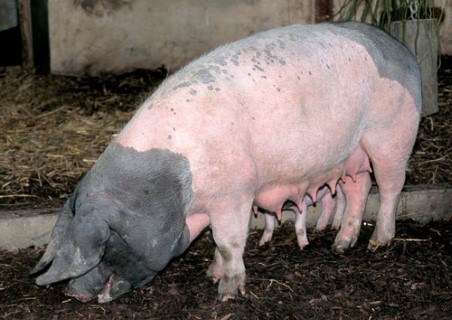 Swabian-Hall Pigs originating from Schwabisch Hall in Baden-Württemberg,
Germany. They are a large pig, white in the center with a black head and rear
and narrow grey bands at the transition from white to black skin. They have
large litters averaging more than nine piglets.
Swabian-Hall Pigs originating from Schwabisch Hall in Baden-Württemberg,
Germany. They are a large pig, white in the center with a black head and rear
and narrow grey bands at the transition from white to black skin. They have
large litters averaging more than nine piglets.They are the result of King Wilhelm going to China and obtaining Meishan Swine and then crossbreeding them with Russian Wild Boar that was indigenous to the country of Germany. He did this because the indigenous pork was too lean and too dry, much the same as the current confinement, heavily muscled, super-lean hogs in the U.S. Swabian-Hall meat was named the world’s best pork in 1832, and then again at the 1892 Worlds Fair.

 Swedish Landrace
Swedish Landrace
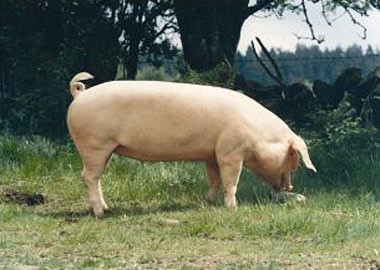 Swedish Landrace Pigs stand as the foremost breed of pig in Sweden, boasting distinctive heavy drooping ears and a pristine white coat. Originating from importations primarily from neighboring Denmark, the Swedish strain of the Landrace pig has flourished and adapted to its Scandinavian habitat.
Swedish Landrace Pigs stand as the foremost breed of pig in Sweden, boasting distinctive heavy drooping ears and a pristine white coat. Originating from importations primarily from neighboring Denmark, the Swedish strain of the Landrace pig has flourished and adapted to its Scandinavian habitat.
These pigs are recognized for their robust build and adaptable nature, making them well-suited to various farming systems and environmental conditions prevalent in Sweden. Their heavy drooping ears serve practical purposes, aiding in their ability to forage efficiently and navigate their surroundings.
The Swedish Landrace Pig''s reputation extends beyond its native country, with its genetic influence and characteristics contrib ...
